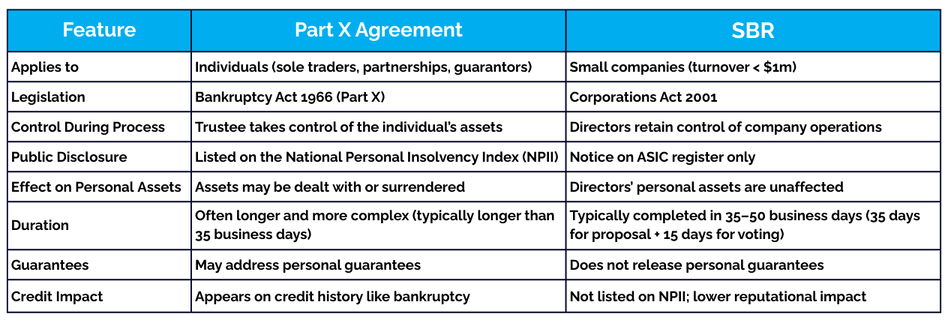When individuals find themselves in financial distress, especially those who are sole traders or have personally guaranteed business debts – it’s natural to ask whether the SBR process, so effective for companies, might also apply to them.
The short answer: not directly. But there is an equivalent solution tailored for individuals — the Part X Agreement (also known as a Personal Insolvency Agreement or PIA).
Although these two processes are governed by different legislation and apply to different types of entities, they are both structured solutions designed to resolve unmanageable debt and avoid more severe outcomes like bankruptcy or liquidation.
Similarities
Despite their differences, SBRs and Part X Agreements share several key features:
- Offer a pathway to compromise: Both aim to facilitate an agreement with creditors to pay a reduced amount of debt. The goal is to help viable individuals or businesses avoid collapse and continue operating.
- Formal, regulated processes: Both require the appointment of a qualified professional to oversee the restructure. A Part X involves appointing a Trustee who takes control of the debtor’s property and negotiates with creditors; while an SBR involves a Small Business Restructuring Practitioner (SBRP) who oversees the debt restructuring process and plans.
- Create breathing room: Initiating either process triggers a moratorium on creditor enforcement action, giving space to prepare and present a restructuring plan.
- Subject to creditor approval: In both processes, creditors vote on whether to accept the proposal, though the voting rules differ slightly. Part X requires 75% approval by both number and value of creditors at the meeting, while an SBR needs approval from more than 50% by value of those who vote.
- Focus on future viability: Both processes focus on ongoing viability — supporting individuals or businesses with the capacity to recover. The aim isn’t just to avoid insolvency, but to provide a practical, forward-looking solution.
Differences
While the principles are similar, the mechanisms and implications vary significantly:
For individuals — particularly sole traders or directors with personal guarantees — a Part X Agreement may offer the closest alternative to an SBR. It delivers the opportunity to avoid bankruptcy, resolve debts in a controlled and negotiated manner, and plan for recovery.
Knowing When a Part X Agreement is Suitable
Recognising the early signs of financial stress is key — especially for individuals with business-related liabilities. As trusted advisors, you’re often in the best position to help clients access the right solutions and support before options narrow.
A Part X Agreement may be worth exploring when:
- The individual is insolvent and wants to avoid bankruptcy.
- They’re under pressure from creditors or facing legal action.
- They’ve provided personal guarantees for a struggling or failed business.
- They intend to continue earning income or operating a business.
In these situations, a Part X offers a structured and respectful way to deal with unmanageable debt, protect income streams, and minimise long-term consequences.
—
At de Jonge Read, we’ve successfully guided many individuals through Part X proposals, achieving outcomes that balance the interests of creditors with the client’s ability to recover and move forward. We understand the emotional and financial toll of personal financial collapse, and we take pride in offering practical, tailored strategies that give clients a genuine path forward.
We’ve helped:
- Sole traders avoid bankruptcy and settle with creditors while keeping their business running.
- Company directors resolve personal guarantees through a coordinated business restructure and personal proposal.
- Partnerships unwind its debts through parallel strategies for the business and individuals involved.
As advisors, you’re often the first to spot the early warning signs. By understanding the options available for both for companies and individuals, you can help your clients take action before it’s too late.
If you’re working with clients facing financial difficulty, whether as directors, guarantors, or sole traders — we encourage you to reach out. A Part X Agreement could be the circuit breaker they need, and the de Jonge Read team is here to guide them through the process. Get in touch with our team to discuss the best approach for your clients. The earlier a strategy is in place, the more options there are to achieve a positive outcome.
Should you have clients or associates that you know are struggling with financial issues or need assistance in reviewing their business affairs in preparation for what’s around the corner, our team of Strategists would be pleased to discuss options that are available on how to best design and implement insolvency strategies. Contact us now on p. 1300 765 080 | ua.mo1746050755c.arj1746050755d@ofn1746050755i1746050755
Did you know?
Phoenixing is another name of business restructure. Read more about business restructures and when this can be an option for you.


